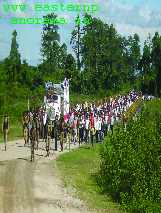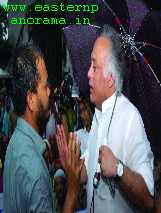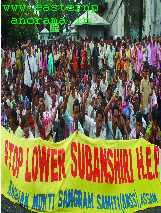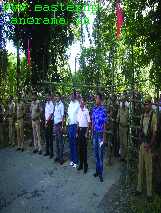Archives
The Power Paradox
The Power Paradox
Mega Dams, the choice between development and environment.
North East India, the land of power resources is caught in a tussle between displacement of people and energy security. The voice of protest against mega dams in the region has once again brought to the fore the notion that projects, when established for the people, has to have the rectification of the people.
mega dams in the region has once again brought to the fore the notion that projects, when established for the people, has to have the rectification of the people.
Now, after spending around Rs 4200 Crore on the biggest power project of the 11th Plan namely the 2000 MW Lower Subansiri power project along the Assam - Arunachal Pradesh border, it has been found that no downstream impact study was conducted for the project. However several claim that there is nothing unusual in this as downstream study is a relatively new concept.
The expert committee constituted to study the downstream impact of the NHPC Limited’s 2000 MW Subansiri Lower Hydroelectric power project in its report has recommended against construction of the mega dam at its present site.
The committee which included experts from Dibrugarh and Gauhati University and the Indian Institute of Technology (Guwahati) was formed after the All Assam Students Union (AASU) protested against the construction of the dam. The decision to form the expert committee was taken by the Ministry of Power, Government of Assam, AASU and NHPC.
The committee has stated, “The present investigation carried out to examine the downstream impact of the dam project reveals gross inadequacy in the relevant facts relating to construction of the dam at the present site by the concerned authorities. The selected site for the mega dam at the present dimension was not appropriate in such a geologically and seismologically sensitive location. The seismic design parameter is not properly chosen for the project.”
The committee observed that according to the investigation, the recommended seismic design parameter is at 0.5 or more. It is recommended not to construct the mega dam in the present site.
From the geological, tectonic and seismological points of view, the expert group suggests not to consider the Himalayan foothills, south of the main boundary trust (MBT) for any mega hydropower project. The committee has suggested the redesigning of the project by sufficiently reducing the dam height and production capacity.
To break the stalemate and get an opinion on the mood of the people, Union Minister for Environment and Forests Jairam Ramesh recently chaired the public consultation meeting in Guwahati which was rife with angry debates.
 Miffed Mr. Ramesh threatened to close the meeting midway after RTI activist Akhil Gogoi had a verbal duel with him. Mr. Ramesh was visibly upset after Gogoi asked him whether he was a NHPC man.
Miffed Mr. Ramesh threatened to close the meeting midway after RTI activist Akhil Gogoi had a verbal duel with him. Mr. Ramesh was visibly upset after Gogoi asked him whether he was a NHPC man.
Ramesh asked the RTI activist to withdraw the remark, which he did. However, the minister lost his temper and roared, “Am I a criminal, a thief that you are talking to me like this? I don’t like the manner in which he (Gogoi) talks to me.”
The minister argued that development of power projects on River Brahmaputra will strengthen India’s negotiating power with China and stated that use of the River Brahmaputra is not only of economic importance but also of strategic importance to India. “We must stringently follow the environment procedure but as a country, if we are to strengthen our negotiating position with China on the use of water, we must develop power projects on River Brahmaputra.”
After sitting through the six hours of the marathon meeting, Mr. Ramesh announced that a comprehensive downstream including environmental impact study for the power projects including Karbi Langpi, Ranganadi, Kopili, Kurichu dam and Umtru dam will made by a competent authority. The study will also suggest remedial measures for these projects which have already been commissioned.
He said that no project will be cleared by the ministry unless a comprehensive impact assessment study including a bio diversity impact study is done. “For rivers having multiple power projects and having multi power developers working we will initiate a comprehensive basin impact study. We will get the study done by the best available people in the country and agencies which are independent and professional.”
bio diversity impact study is done. “For rivers having multiple power projects and having multi power developers working we will initiate a comprehensive basin impact study. We will get the study done by the best available people in the country and agencies which are independent and professional.”
He promised that he would appraise Prime Minister Manmohan Singh and the Power Minister Sushil Kumar Shinde about the concerns of the people of Assam that the construction work on 2000 MW Subansiri Lower Hydroelectric power project must be stopped till the expert group studying the downstream impact has a discussion with NHPC authorities.”
The minister observed that the country needs power. The hydro power potential of the country is estimated at 1, 50,000 MW, of which only 37,000 MW has been tapped into.
NHPC limited assured that necessary measures are being incorporated in the disaster management plans of the downstream areas in close co-ordination with the district disaster management cell for the project.
Physical work at the project site had started in 2003. AASU and Krishak Mukti Sangram Samiti (KMSS) has demanded a halt to the work. Even the Assam Assembly House committee, in its report had suggested the stopping of work at the project site.
 According to a statement of NHPC, “Construction of the project work started in January, 2005 only after NHPC received all the statutory clearances including the environmental clearance and the consent of the State Governments of Assam and Arunachal Pradesh.”
According to a statement of NHPC, “Construction of the project work started in January, 2005 only after NHPC received all the statutory clearances including the environmental clearance and the consent of the State Governments of Assam and Arunachal Pradesh.”
The statement added that NHPC initiated the process of study of downstream impact assessment on the suggestion of the Prime Minister’s office in April 2006. “All issues raised by the Study Group were discussed with the members of the Study Group in detail by NHPC officers along with experts in the field of earthquake engineering. A visit to the Bhakra Dam Project located in a similar tectonic setup was also undertaken by the Study Group.”
The statement argued that the Study Group has raised apprehensions on the feasibility of the present dam location and suggested the shifting of the dam to a new location on geological considerations and / or redesigning of the dam. Bhakra Dam (226m high), Kalagarh (Ramaganga Dam – 125m high) and Mangla Dam (Pakistan – 116m high) have all been built in a similar belt and have been performing satisfactorily.
According to the statement, the reservoir will be operated 15 meter below the full reservoir level during the monsoon season which gives storage space in the reservoir during most of the flood season. The flood water as received in the reservoir shall be released safely through the spillway. During operation stage, the reservoir levels shall be monitored closely at regular intervals i.e hourly or less during the flood season.
The 8x250 MW Lower Subsansiri project was envisioned to harness waters from the river Subansiri that flows from Arunachal Pradesh into Assam where it merges with the Brahmaputra.
Assam Chief Minister Tarun Gogoi has asked NHPC CMD, S.K Garg to constitute a multi-disciplinary committee. Mr Garg observed, “We respect the observations and sentiments of the expert group and the house committee on the Lower Subsansari power project. We want to assure everyone that safety of the people is paramount. We are trying to address the apprehensions of the people. We will address the concerns of the downstream people.” However the company is in no mood to suspend the work at the project site Mr Garg said, “I don’t think this will be a fruitful step. The project has obtained all the requisite statutory clearances. Those issues which have been pointed out, we will try to resolve those as early as possible. When there is big dam, people may have doubts”
observations and sentiments of the expert group and the house committee on the Lower Subsansari power project. We want to assure everyone that safety of the people is paramount. We are trying to address the apprehensions of the people. We will address the concerns of the downstream people.” However the company is in no mood to suspend the work at the project site Mr Garg said, “I don’t think this will be a fruitful step. The project has obtained all the requisite statutory clearances. Those issues which have been pointed out, we will try to resolve those as early as possible. When there is big dam, people may have doubts”
The Chief Minister told Mr. Garg that in view of the resentment among the members of the public on the downstream impact of the dam on bio-diversity and the environment as a whole, NHPC should take care of all the issues and address them properly leaving no scope for any resentment from any quarter.
“The dam must not pose any threat to the environment and all steps must be initiated to protect the environment, including the rich bio-diversity of the state,” the Chief Minister added.
Sunaina

